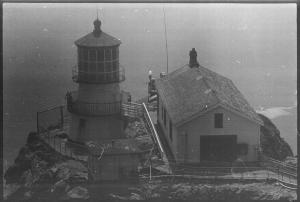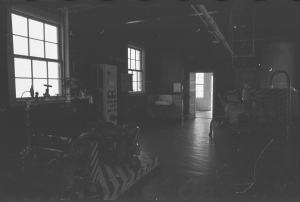
How did I come by the picture above? Did I run it through an "old photo" filter
in the GIMP? Did I dig it out of some ancestor's
steamer trunk in the attic? No, I took it in 1997 on Ektachrome Elite slide film.
 I had just discovered the concept of travel, and gone on a month-long tour of
California with friends. Naturally I had my good camera along, and a large tupperware
container full of rolls of film. Alas, on day 3 of the trip I opened my knapsack
while sitting on a rock next to this pond
here, and the camera fell out. It took
several bounces over the rocks and with a disheartening sploosh, sank into the
murky depths. A few bubbles came up.
I had just discovered the concept of travel, and gone on a month-long tour of
California with friends. Naturally I had my good camera along, and a large tupperware
container full of rolls of film. Alas, on day 3 of the trip I opened my knapsack
while sitting on a rock next to this pond
here, and the camera fell out. It took
several bounces over the rocks and with a disheartening sploosh, sank into the
murky depths. A few bubbles came up.
Hint: Don't do this.
The camera could not be reached from dry land. It was early in the morning and
there was nobody around, so I could ignore the "no swimming" (and implied "no
skinny dipping") sign and go in after it. One of my sneakers got away from me,
bounced over the rocks, fell in the water, and floated away like a little boat.
It was actually lovely water to swim in, just the right temperature.
Green murky water ran out of the camera when I recovered it.
I had no camera for the rest of the trip. What a novel sensation, having to
enjoy the scenery for its own sake rather than concentrating all the time on juggling
5 pounds of photo equipment and saving the experience for later by photographing
it (but missing out on it in the present.)
Anyway, the first thing I did was rewind the camera and take the film out. Then
I took off what could be taken off, being the battery, the lens, the back, the bottom cover,
and the viewfinder focusing screen, and ran a great deal of clean tap water through it
while putting it through its mechanical motions. It seemed to work, but then it
jammed up and would not unjam. I let the camera and lens dry as best I could in
the summer heat, then packed them away. I might have bought a new camera body, but
the lens that took the bath was my 28mm, and the combined price for an Olympus OM1
and a decent 28mm lens on short notice in tourist California was more than I
felt the trip's photos would be worth.
After I got back to Ottawa I started calling camera repair places. All said
"throw it out." I was sentimentally attached to the camera however, so I finally got
someone to look at it, and when the repair estimate came to $225 including tax for
the camera and lens I went for it. A decent secondhand replacement body and lens
of similar quality, bought in the stores, would have cost at least $350+tax. It seemed
that the camera had suffered more damage from bouncing over the rocks (while in its
leather case) than from the water; I was told the mirror box was cracked.
When I got it back, the shutter speeds weren't right. When I got it back the second
time it seemed to work but then it turned out to have a light leak so I had to take
it back again. It has since developed weirdness in the slowest two shutter
speeds, and the light meter needle sometimes gets a little bit stuck so an exposure
error can result if I don't watch for it. I have, however, taken over two hundred
pictures with it since and they came out OK, so maybe this camera will still last
me to the end of the film photography era.
Knowing what I know now, if I was going through this again, I would not have the
camera repaired. It will never be the same as before.
Oh yes, about the film. Nobody would touch it when told where it had
been, and I didn't want to lie to anybody, maybe they were right and it would
pollute their chemicals and ruin other people's films. So I finally tried some
black-and-white chemicals that I had around, just to see what would happen.
The developer came out bright orange. The film came out a semi-opaque green
colour with very faint monochrome negatives -- you can barely see them.
The HP PhotoSmart scanner pulls the pictures off as low-contrast sepia-toned
positives, with a charming "old photo" look to them, which is partly lost when
converting to straight monochrome and tinkering with the contrast, as with the
picture at the top of this page.
Oddly, among all the faint negatives there is one that is much denser than the
rest. Here is the picture, just as the PhotoSmart software saved it. The shadow
detail is almost as good as with real black-and-white film. I must have really
overexposed this picture.

These pictures are of the Point Reyes Light Station north of San Francisco.
Back to my photography page
 I had just discovered the concept of travel, and gone on a month-long tour of
California with friends. Naturally I had my good camera along, and a large tupperware
container full of rolls of film. Alas, on day 3 of the trip I opened my knapsack
while sitting on a rock next to this pond
here, and the camera fell out. It took
several bounces over the rocks and with a disheartening sploosh, sank into the
murky depths. A few bubbles came up.
I had just discovered the concept of travel, and gone on a month-long tour of
California with friends. Naturally I had my good camera along, and a large tupperware
container full of rolls of film. Alas, on day 3 of the trip I opened my knapsack
while sitting on a rock next to this pond
here, and the camera fell out. It took
several bounces over the rocks and with a disheartening sploosh, sank into the
murky depths. A few bubbles came up.
